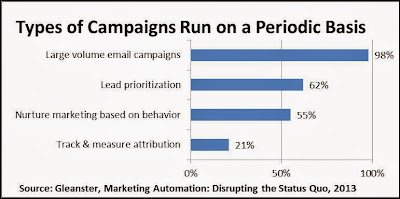Last week’s post on marketing automation and its discontents prompted several questions about whether the level of dissatisfaction is any higher with marketing automation than other systems. To some extent, this is asking whether the glass is half empty or half full; and, as the illustration suggests, the answer matters less than the fact that there’s room for improvement. But I do have some data to share on the question of relative dissatisfaction.
The first insights come from G2 Crowd, a research firm that ranks software based on user ratings and social data. I have my doubts about comparing software this way* but users certainly know whether or not they're happy. The folks at G2 were kind enough to reformat some of their data for me.**
According to the G2 figures, marketing automation users are in fact more enthusiastic about their choices than almost anyone else. CRM in particular has a vastly worse rating, but even email, Web analytics, and Web content management show more detractors and fewer promoters. I’m not sure how to interpret this – is the average marketing automation system really easier and better than those other types of software? Or is something else going on: maybe satisfaction is lowest in the most mature categories, like human resources, enterprise resource management, and accounting, because experienced users are the most demanding?
A second set of insights comes from Ascend2 and Research Partners, which asked its panel which inbound marketing tactics they considered most effective and most difficult to execute. Here we see a very different story: marketing automation and lead nurturing (listed separately) are clear outliers in a bad way: among the less effective tactics and the hardest to execute. In fact, they are the only two tactics where the difficulty score was significantly higher than the effectiveness score (i.e., above the diagonal line in the chart below).***
The Ascend2 study also found that 18% of respondents used marketing automation extensively, while 43% made limited use of it, and 39% didn’t use at all. This is similar to the BtoB study I cited last week, which found that just 26% of marketing automation users had fully adopted their system. I believe those effectiveness vs. difficulty ratings hint at the reason for those results: most marketers don’t fully deploy marketing automation because they find it too much work compared with the benefit they’d gain. In other words, the hurdle to marketing automation adoption is not laziness, but a rational evaluation of the return from investments in marketing automation vs. other activities.
That rational judgment could still be wrong. After all, marketers who haven’t fully deployed marketing automation don’t know how effective it really is. Ascend2 addressed this by asking marketers to rate their performance and comparing answers of the 12% self-rated “very successful” with the 20% who rated themselves “not successful”.
Those answers contain some positive news: of the very successful group, 45% were extensive users of marketing automation, compared with just 9% of the not successful.
But even the very successful marketers gave marketing automation only the fifth-highest effectiveness rating, which doesn’t differ much from the sixth-highest rating in the not successful group.
Similarly, the very successful marketers rated marketing automation as sixth most difficult (actually, tied for fifth) while the not successful marketers ranked it as fourth-hardest. In other words, marketing automation is indeed a bit easier than it seems before you start, but even the most experienced and most successful marketing automation users consider it pretty darn hard and just modestly effective.
So what we have here is a mixed message: marketing automation does correlate with success and its users might even be relatively satisfied, but it's still a lot of work for limited results. You read that as good news or bad, but, either way, it shows the need for more work before marketing automation can reach its full potential.
________________________________________________________________________
* My basic objection is that users have different needs, so a system that satisfies one user may not be good for another.
** G2’s explanation: “The data for this chart comes from the over 7,400 enterprise software surveys users have completed on G2 Crowd as of Friday 10/18/13. For every product review we ask "How likely is it that you would recommend this product to a friend or colleague?" on a 0-10 scale. We segment reviewers that rate a product 9-10 as Promoters, 7-8 as Passives, and 0-6 as Detractors. The product segmentation data is aggregated to determine Net Promoter Score at a category level.”
***It's barely possible that the answers would be different if the Ascend2 study had asked about marketing in general rather than "inbound marketing purposes". But I doubt it.





















